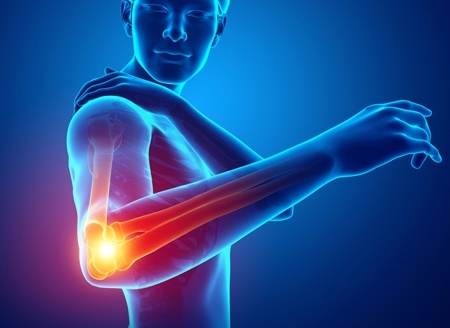As Wisconsinites shovel their way through the recent snowfall that graces the midwest each and every year, the physicians at Orthopaedic Associates of Wisconsin anticipate the injuries that often result. Nine times out of ten, snow shoveling goes without any incident. However, sometimes the wettest, heaviest snow or a slip on the ice can cause the biceps tendon to rupture.
When the strenuous lifting part of shoveling goes awry for someone, the distal biceps tendon connecting the muscle to the elbow or the proximal biceps tendon that connects the muscle to the shoulder can rupture. These tears can also result from repetitive movement putting undue stress on the tendons. Proximal tears are more common than a distal biceps tendon tear. Regardless of location, the tear can be either a partial tear that leaves some of the tendinous fibers intact or a complete rupture that more significantly affects the functionality of the muscle. Patients over 40 years of age are at a higher risk of sustaining this type of injury because they are still exerting considerable strength in daily activity but their tendons have weakened over time and are more susceptible to rupture.
Patients are typically aware when they have ruptured the biceps tendon. At the time of injury, an audible pop or snap is often heard or felt. A visible deformity called a ‘Popeye Deformity’ appears when the long head of the proximal biceps tendon is torn and falls into the belly of the muscle. Bruising, swelling, and soreness may occur in the general area where the injury happened, but at least some semblance of function remains. Depending on the location of the tear, some weakness and reduced motion may be noted. Then it’s time to see the doctor.
Proximal tendon ruptures do not require surgical intervention. The arm is typically put in a sling for both comfort and brief immobilization. Because the tendon attaches at two points at the shoulder, the loss of one of those points does not significantly reduce strength or motion, and the arm still functions adequately. Depending on age and activity level, distal biceps tears are also sometimes treated conservatively with rest, brief immobilization, and formal physical or occupational therapy. For relatively young, active individuals (especially if it is the dominant arm), distal biceps ruptures may require surgical intervention to re-attach the tendon to regain full function of the arm.
Surgical intervention involves securing the torn tendon back to the bone. After the incision is closed, the arm is placed in a splint. Your surgeon will see you back in our clinic about ten days after surgery to remove your splint and check your incision. Then you will likely be fitted for a hinged elbow brace that will start out locked with your elbow at 90 degrees to prevent motion that could disrupt the repair. As time progresses, motion is gradually increased as therapy progresses. Eventually the brace is discontinued so general function and strengthening can progress and you can get back to your normal. As with any injury, each surgeon has his or her own protocol to see you through a successful recovery.
If snow shoveling got the best of you, find a friend with a snowblower and then give us a call!
This blog is written by one of our very own-Morgan. She is a certified athletic trainer working as a medical assistant with our providers each and every day in our clinic. She obtained a bachelor's degree in athletic training from Carroll University in Waukesha and a master's degree in Kinesiology from Michigan State University. She is excited to bring you updates and information about the happenings at OAW.

